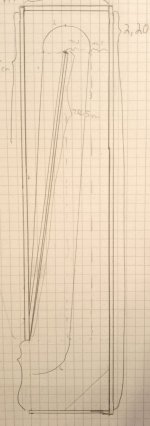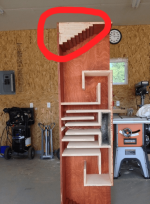So. While listening to my new Kirishima-horns, I was reading up on BIB-versions.
Most likely in the near future I will live with neighbours above and/or below me.
Depending on the circumstances, I don't know if a "true" BIB will be "socially acceptable" when the vent is boosting its bass onto the ceiling or the floor.
(The drivers I have in mind are the W8 2145 by Tangband, or maybe the W8 1772, I haven't decided yet.)
Then I doodled around and had an idea. Why not move the vent around a little and have it pointed to me, the listener, like in a regular Voigt Pipe? Maybe add a deflector or a little "stairs triangle" (don't know the english word for it, I attached a picture with a red circle around it).
It's also possible to make the vent area as big as it were naturally on the top/bottom.
So I sat down with the BIB-excel sheet v.2 and entered some rough measurements just to try it out in a sketch.
I guess the questions I have, are the following:
1. Does a BIB really throw out so much bass at the ceiling/floor?
2. If it does, why not move the port around? Is it feasable/doable, or did I overlook some details that kill my idea?
What are your thoughts on this?
Most likely in the near future I will live with neighbours above and/or below me.
Depending on the circumstances, I don't know if a "true" BIB will be "socially acceptable" when the vent is boosting its bass onto the ceiling or the floor.
(The drivers I have in mind are the W8 2145 by Tangband, or maybe the W8 1772, I haven't decided yet.)
Then I doodled around and had an idea. Why not move the vent around a little and have it pointed to me, the listener, like in a regular Voigt Pipe? Maybe add a deflector or a little "stairs triangle" (don't know the english word for it, I attached a picture with a red circle around it).
It's also possible to make the vent area as big as it were naturally on the top/bottom.
So I sat down with the BIB-excel sheet v.2 and entered some rough measurements just to try it out in a sketch.
I guess the questions I have, are the following:
1. Does a BIB really throw out so much bass at the ceiling/floor?
2. If it does, why not move the port around? Is it feasable/doable, or did I overlook some details that kill my idea?
What are your thoughts on this?
Attachments
The terminus of a voigt like the BIB needs to be extended by the room, ideally a corner. This can be the ceiling (regular BIB) or the floor (invertedBIB) where the driver does not lead to a large enuff pipe to reach the ceiling.
This because the box is not big enuff.
The Karlson slot in the iBIB is intended to make the end of the line more “squishy” and spread out the unwanted harmonics a bit more making them less of an issue.
Deflectors are usuullay counterproductive.
dave
This because the box is not big enuff.
The Karlson slot in the iBIB is intended to make the end of the line more “squishy” and spread out the unwanted harmonics a bit more making them less of an issue.
Deflectors are usuullay counterproductive.
dave
Ahh, okay, so my idea doesn't really work then because it's lacking the corner/ceiling/floor-loading that normal BIBs or the iBIBs have, right?
Without extending the “horn” mouth one will get significant ripple.
Boxes like the Frugel-Horns or the Woden Megaliths also use what is behind them to extend teh mouth size, but the BIB is more critical.
dave
Boxes like the Frugel-Horns or the Woden Megaliths also use what is behind them to extend teh mouth size, but the BIB is more critical.
dave
Correct, need to view them acoustically as just a huge OB folded up to fit inside a room, so without any back pressure to compensate, the driver will just 'flap in the breeze' same as an OB below its upper mass corner (Fhm = 2*Fs/Qts') where T/S theory box design peters out.Ahh, okay, so my idea doesn't really work then because it's lacking the corner/ceiling/floor-loading that normal BIBs or the iBIBs have, right?
(Qts'): (Qts) + any added series resistance (Rs): http://www.mh-audio.nl/Calculators/newqts.html

